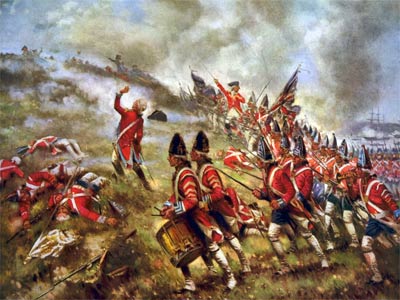Redcoat Leaders Weren't All Dolts
Mini Teaser: The British generals who lost the American Revolution were hardly incompetent fools.
Clinton bitterly complained that he faced an impossible task with insufficient means. He had foreseen the events that led Burgoyne to disaster and pressed Howe to fight in New York rather than Pennsylvania. O’Shaughnessy describes him as providing “the most incisive accounts by a contemporary of the strategic shortcomings of the British war in America,” but the embattled general’s insights gave him little solace. Clinton also perceived problems in the British tendency to occupy territory but then withdraw, leaving behind disappointed loyalists now powerless to help the cause. He urged that ground taken be held and garrisoned as part of what later would be termed a counterinsurgency effort. Orders to release troops from his command for service elsewhere, however, nullified that strategy as well as any conventional offensive.
The British capture of Savannah presented a chance to test his approach. It demonstrated an American weakness in the South that Clinton exploited in early 1780 with his siege and capture of Charleston, along with seven American generals, more than 2,500 Continental army regulars, and artillery and supplies. It marked the greatest American defeat of the war. Pockets of loyalist support offered a chance to restore British authority in the Carolinas, particularly as regular American opposition in the region had been decimated, leaving only partisans who could be suppressed through counterinsurgency efforts. The war seemed to have turned dramatically in Britain’s favor.
Clinton left further operations in the South to Cornwallis, who had proved his ability in campaigns since 1776. He did not, however, leave Cornwallis a force large enough to garrison territory while conducting operations elsewhere. Nathanael Greene, sent by Washington to salvage the Continental army in the South, coordinated with partisans and maneuvered to avoid tactical defeats. Then Cornwallis made a fateful mistake. Rather than adopting a defensive posture to consolidate British control in South Carolina, he opted to go after Greene. O’Shaughnessy notes parallels between Burgoyne’s march to Saratoga and Cornwallis’s later move to Yorktown. Both generals disregarded orders, overextended their supply lines and suffered attack from enemy militias.
Although Cornwallis gave “a fair trial to the ardent wishes of government at home,” he soon found loyalist support illusory. Pyrrhic victories diminished his force and left the British exposed in South Carolina. Admiral Thomas Graves likened the British Army’s movements in America to “the passage of a ship through the sea whose track is soon lost.” Cornwallis still appeared to be a formidable enemy when he invaded Virginia in spring 1781. But despite creating pandemonium there after an epic march through the Carolinas, he failed to gain traction. Clinton ordered him to establish a post on the Chesapeake with plans for shifting much of the army for a campaign elsewhere. Washington, however, marched French and American troops to Virginia just as the Royal Navy lost control of the sea. Yorktown became a trap rather than a refuge or escape, and Cornwallis surrendered his army on October 19, 1781. The fox, as O’Shaughnessy remarks, had caught the hound.
When news of Yorktown reached London, North responded as if he had been shot. “O God! It is all over!” he exclaimed. Germain and George III showed more fortitude. Although Yorktown decided the contest in America, the larger war remained far from over. Admiral George Rodney’s victory in the Caribbean saved Britain’s position in the West Indies, while Gibraltar withstood a Spanish attack. The feared erosion in Britain’s global position stemming from defeat in the thirteen colonies never materialized.
WHAT WENT wrong for Britain in North America? A large part of the problem, O’Shaughnessy demonstrates, was that its mission was an impossible task. Britain never had the ground or naval forces needed to conquer and hold America. The navy could support army operations or blockade the colonies before 1778, but not both. The war’s expansion only widened the gap between ends and means. Support from loyalists fell short of what both politicians and commanders expected. Loyalists, far from helping subdue the rebels in any serious way, left the British to carry the war’s burden largely alone. The army had to defeat regular American forces while fighting persistent counterinsurgency efforts and drawing supplies across the Atlantic. Neither the British government nor its commanders managed to solve this problem of scale or reframe the challenge in a more manageable way, and not even the most impressive victories could shift the strategic balance.
O’Shaughnessy’s focus on the men who lost America accentuates the larger failure to balance goals with resources or coordinate distant operations effectively. Comparing his story with the British experience in other conflicts underlines the point. Britain overcame weaknesses and leveraged strength when commanders and their political masters in London worked in tandem. They failed that test in the American war. Yet even though Britain lost in America, it held ground elsewhere and laid a foundation for recovery. Defeat did not reduce Britain to a third-rate power, and its revival in the 1780s positioned it for a more crucial strategic struggle against revolutionary and Napoleonic France. It seems that the lessons demonstrated by the men who lost America guided Britain in that later conflict and the age of empire that followed.
William Anthony Hay is an associate professor of history at Mississippi State University specializing in British history and international relations since the eighteenth century.
Pullquote: The growing tension within Britain's Atlantic empire fit within a larger dynamic of conflict between central governments and distant provinces.Image: Essay Types: Book Review
Essay Types: Book Review 